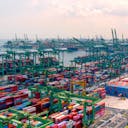An electronic bill of lading (eBL) will transform information exchange in container shipping. Currently mostly paper-based, the bill of lading serves as document of title, receipt for shipped goods and a record of agreed terms and conditions. An eBL will speed up information exchange, cut costs and improve the customer experience and sustainability.
DCSA has published data and process standards for the eBL and has completed a proof of concept (PoC) trial with platform providers. This tested eBL interoperability through the full bill of lading lifecycle using data mirroring a live shipment.This article is part of a series, discussing the PoC with participants. Here, we hear from Peter Kern, Chief Commercial Officer of document transfer solutions specialist CargoX. We began by asking:Why do you think the eBL PoC interoperability collaboration is important?
The eBL PoC interoperability collaboration is the best way to really test interoperability standards in real-life scenarios. This is the most efficient method to see whether the standards provide everything necessary to their end users.At the same time, this method enables DCSA to improve the standards by obtaining feedback from participating technology providers, shippers, exporters, importers, agents and others. The improved standard can accommodate many new functionalities, such as identities and participating platform features. For example, together we upgraded the standard to provide requirements for a logbook of document creation and subsequent events related to document transfer, i.e., who the possessor or title holder was at any given time.The PoC makes it possible for everyone to focus on the real electronic BL document process and contribute their evaluations, thoughts and ideas on how to provide interoperability for global trade audiences.What results have you seen so far?
All partners in the PoC have verified the technological feasibility of an electronic Bill of Lading transfer from one eBL platform to another, while preserving and maintaining all the necessary records and line of trust needed for a successful business transaction.Our conclusion is that the concept is satisfactory and it works. In technical terms, we use a PUT request to transmit the document, we have achieved valid participant identification, and the document was transferred according to the desired workflow. This technical milestone unlocks the full potential of global electronic trade documentation processing.What lessons have you learned during this PoC?
We confirmed that through sincere collaboration and open communication truly great achievements are possible. The PoC group standardisation body, assembled from industry leaders and technology providers with different methodologies and solutions, has put the emerging standard and interoperability effort into focus to provide a standardised solution that can be adopted technologically worldwide. And this was achieved in record time.The next step is coding the interoperability features into the different technology platforms, where new benefits will emerge and kick-off global business transformation. If anybody is still wondering – interoperability is here and we are ready for it.What are the benefits for your customers once we achieve platform interoperability?
Once interoperability is achieved, electronic trade records will be moving through various systems for true efficiency and transparency in cross border trading. Customers will gain access to a broader trade ecosystem, allowing faster trade facilitation, access to new ways of financing, eliminate double data entries when communicating with trade participants and regulators, such as National Single Windows or customs systems.Interoperability will provide cross-platform, auditable document exchange. This will remove a lot of friction in trade document processing, as well as boost productivity and lower cost.What does a fully interoperable eBL mean for international shipping and trade?
Exercising paperless trade is the greatest achievement. Electronic BLs can be created directly in the ERP systems of companies and transferred securely through our blockchain-based platform for document transfers. From there, they find their way either through blockchain onto other platforms to reach their recipients, or they change their electronic format – but not their content! – and reach their recipients on classic IT-based platforms.At all times, a log of all the events is maintained in the most trustful way, along with the details of sender/recipient identities, and the proof of document originality and content consistency. All this functionality is provided while cost is reduced drastically, and time of delivery is shortened from weeks to just a few seconds.What is really amazing, is that this is not just about electronic bills of lading! Our platform supports more than 70 different document types. Among them letters of credit, contracts, commercial invoices, packing lists, certificates of origin and other certificates and documents. The list is growing, and we are constantly adding new types of documents and envelopes.Has anything come out of this PoC experience that was perhaps unexpected or rewarding that you want to share with the industry?
As much as the industry is based on competition and business confidentiality, this PoC project has proven once again that collaboration is good and necessary if we want to resolve industry-wide issues that hold back global trade overall.Efficient collaboration has been established among market competitors, providing a starting point for a future symbiotic relationship in the market. This will be necessary as interoperability also relies on agreed-upon financial, legal, and business strategic aspects. It is also essential for digitalisation to move forward. Silo-building and island-like isolation have proven to be unproductive in this segment of services.What is even more encouraging, is that the interoperability standard is technology-agnostic. eBL systems can communicate to provide frictionless documents of title exchange to their respective customers, while preserving the lowest common denominator in this process – trust in content origin and the trail of possession transfer.
Digitalise the container shipping industry
At DCSA, we envisage a digitally interconnected container shipping industry in which customers have a choice of seamless, easy-to-use services that provide the flexibility to meet their business and sustainability goals.









